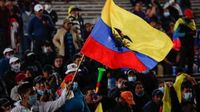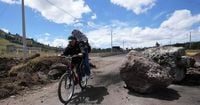On Sunday, October 5, 2025, the streets of Quito were alive with the sounds of protest and counter-protest as Ecuador found itself at the heart of a deepening national crisis. The spark? President Daniel Noboa’s controversial decision to scrap a longstanding diesel subsidy, a move that has sent fuel prices soaring and ignited a fierce backlash from Indigenous groups, transport unions, and a variety of other sectors. The government’s response—a sweeping state of emergency across 10 provinces—has only heightened tensions, raising pressing questions about democracy, stability, and the high-stakes economics of subsidy reform.
It all began in earnest nearly two weeks before, when Ecuador’s largest Indigenous organization, the Confederation of Indigenous Nationalities of Ecuador (Conaie), took to the streets. Their rallying cry was simple but powerful: the removal of the diesel subsidy, which hiked prices from $1.80 to $2.80 per gallon, threatened the livelihoods of millions. “Diesel goes up, everything goes up,” chanted protesters in Quito’s parks, their voices echoing the economic anxiety felt across the nation. According to Bloomberg, Conaie’s president, Marlon Vargas, didn’t mince words when he warned, “If the government ignores us, I believe we will be convinced to take Quito.”
The government, for its part, saw the writing on the wall. Late on Saturday, October 4, President Noboa declared a 60-day state of emergency in 10 of Ecuador’s 24 provinces, citing “serious internal unrest” and a need to “safeguard public order, internal security, and the well-being of the people.” The decree, as reported by Xinhua and Bloomberg, suspended the right to public assembly, banned gatherings that might disrupt essential services or threaten public safety, and gave broad powers to police and the military. “The armed forces and national police are authorized to deploy as needed to maintain order and prevent violence,” the presidential office stated.
This was no idle threat. The affected provinces—many with large Indigenous populations—had already seen a spike in unrest. Road blockades, attacks on security forces, property damage, and even the seizure of cargo vehicles were reported by officials. In Imbabura province, a flashpoint for the protests, one civilian was allegedly shot by authorities, and a group of soldiers was kidnapped and beaten before being released. Nearly 100 people were detained during a violent clash a week prior, and some military personnel were briefly held by demonstrators. On Sunday, protesters demanded the release of detainees, including 13 individuals accused by prosecutors of terrorism. The Confederation of Indigenous Nationalities decried the crackdown, stating that Noboa’s emergency decree “deepens his war policy” against the legitimate demands of the population and called on international human rights organizations to remain vigilant.
Yet, the government refused to budge. President Noboa, in a message posted to X (formerly Twitter), drew a hard line: “Those who choose violence will face the law. Those who act like criminals will be treated as criminals.” Minister of Government Zaida Rovira echoed this sentiment, telling reporters on Sunday that Ecuador “has grown tired of violence.” Edgar Lama, president of the Social Security Board, dismissed the protesters as a “minority that seeks to impose its will through violence.”
Pro-government supporters, meanwhile, staged their own events. In El Arbolito Park, an art fair attended by ministers and other officials unfolded under the watchful eyes of police and military forces. The contrast was striking—a government eager to project normalcy and cultural vitality, even as the streets outside bristled with anger and uncertainty.
The roots of the crisis run deep. Ecuador has long struggled with the burden of fuel subsidies, which cost the country an estimated $1.4 billion last year alone, according to Bloomberg. Previous attempts to slash these subsidies by former presidents Lenin Moreno and Guillermo Lasso ended in failure, as widespread protests forced both leaders to back down. This time, however, bond investors are betting that Noboa will succeed where his predecessors could not, seeing his willingness to confront unrest as a sign of political resolve.
But at what cost? The state of emergency, which is set to last 60 days, restricts not only the right to assemble but also bans public gatherings that could disrupt vital services or pose risks to public safety. While the decree stops short of banning peaceful demonstrations outright, the reality on the ground is far more fraught. Police have used tear gas to disperse protesters attempting to breach security cordons, and the specter of further violence looms large.
The opposition is not limited to Indigenous groups. Transport unions, labor organizations, and other sectors have joined the chorus of dissent, all demanding the repeal of Decree 126—the presidential order that eliminated the diesel subsidy on September 12. Conaie has called for a national strike, and the protests, now in their 13th day as of October 6, show no signs of abating. Road blockades have disrupted commerce, including the lucrative flower export industry, and sporadic clashes with security forces continue to flare up.
For many Ecuadorians, the issue is not just about fuel prices. It’s about the broader question of who bears the brunt of economic reforms. As one protester’s sign put it, “Out with Noboa.” The sense of betrayal is palpable among those who feel excluded from the decision-making process and left to shoulder the burden of austerity. The government, for its part, insists that the reforms are necessary to stabilize public finances and ensure long-term prosperity.
International observers are watching closely. The Confederation of Indigenous Nationalities has called on human rights organizations to monitor the situation, warning that the government’s heavy-handed response threatens to undermine democratic norms. The constitutional court’s decision to annul an earlier, narrower state of emergency in five provinces on October 3 underscores the legal and political complexities at play.
As the crisis enters its third week, the stakes could hardly be higher. Will President Noboa’s gamble pay off, ushering in a new era of fiscal discipline and political stability? Or will the mounting unrest force yet another retreat, as has happened so many times before in Ecuador’s turbulent recent history? For now, the only certainty is uncertainty itself—a nation on edge, searching for a way forward.
In the shadow of Quito’s parks and plazas, the voices of protest and power continue to clash, each side convinced of its own righteousness. The days ahead will test not only Ecuador’s leaders but also the resilience and resolve of its people.

